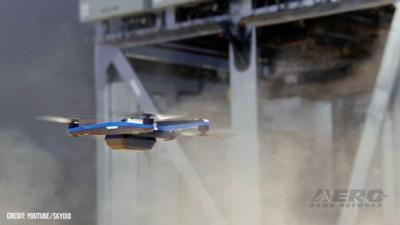Flying the Grid
The New York Power Authority (NYPA)—America’s largest state public power organization and the operator of 16 generating facilities and more than 1,400-circuit-miles of transmission lines—announced on 16 February 2023 that it had received Federal Aviation Administration (FAA) approval to employ its Unmanned Aircraft Systems (UAS) in Beyond Visual Line Of Sight (BVLOS) operations.

BVLOS denotes operation of a Remotely Piloted Aircraft (RPA) under conditions in which the device’s pilot is either unable to maintain direct, unaided visual contact with it, or the RPA and pilot are separated by a distance of greater than four-hundred-meters.
The aforementioned approval takes the form of an FAA waiver, and authorizes NYPA to conduct fully remote drone operations in support of undertakings such as asset and vegetation-management inspections at its Blenheim-Gilboa Pumped Storage Power Project in East-Central New York State’s Schoharie County.
NYPA’s drone program helps safeguard and maintain the company’s assets, and is part of an Authority-wide digitization initiative by which NYPA seeks to modernize its grid infrastructure for purpose of advancing the efficient delivery of clean power to its customers throughout the Empire State.
New York Power Authority acting president and CEO Justin E. Driscoll stated: “The Power Authority is proud to be leading the way in the advanced deployment of automated flight technologies for use in the utility industry. Drones will become an even more valuable tool as we expand our capability to detect infrastructure issues and support our mapping and land management responsibilities. Being able to capture images remotely, regardless of weather conditions or distances, will allow us to track and evaluate our assets more efficiently and safely.”
Part 107 of the Federal Aviation Regulation—that facet of FAA governance germane to the operation of commercial UAS vehicles—requires drone pilots to maintain visual contact with aerial vehicles under their control. The newly-secured waiver allows UAS pilots in the service of NYPA to operate their machines without benefit of visual contact, provided the routes flown are pre-planned and the UAS remains at or below fifty-feet-Above-Ground-Level (AGL) or within fifty-feet of structures.
The waiver was obtained with assistance from Skydio, a U.S. manufacturer of Unmanned Aerial Systems and software, and a provider of UAS-associated equipment and advisory services.
Skydio senior director of regulatory affairs Jenn Player remarked: "This important approval enables NYPA to operate Skydio drones beyond line of sight without visual observers. Skydio autonomy and collision avoidance capabilities are key to conducting these low-altitude, high-value operations safely and easily."

NYPA’s BVLOS waiver is specific to Skydio drones, and authorizes such operations through 2027. The waiver’s issuance and period of validity correspond to the launch of a new Skydio UAS docking App that enables drones to take-off from and land autonomously on the dock under the control of a remotely located pilot.
NYPA’s UAS program manager Peter Kalaitzidis set forth: “Our application demonstrated to the FAA that we are ready to enhance our program and capabilities. Having this waiver removes limitations and unlocks opportunities moving forward. We will continue to explore potential uses for this technology that will benefit the Authority and hopefully the industry at large. At present, we are developing the procedures, mitigation steps, and hardware so we can best use these resources over the next few years.”
At present, NYPA’s in-house UAS program is researching and testing means by which to implement drones more fully into the company’s day-to-day utility operations while maintaining the highest standards of aviation professionalism and safety. Across New York State, more than forty NYPA drone pilots are engaged in supporting projects ranging from vegetation management to line inspection to project monitoring.
 Bolen Gives Congress a Rare Thumbs-Up
Bolen Gives Congress a Rare Thumbs-Up The SportPlane Resource Guide RETURNS!!!!
The SportPlane Resource Guide RETURNS!!!! Buying Sprees Continue: Textron eAviation Takes On Amazilia Aerospace
Buying Sprees Continue: Textron eAviation Takes On Amazilia Aerospace Hawker 4000 Bizjets Gain Nav System, Data Link STC
Hawker 4000 Bizjets Gain Nav System, Data Link STC Echodyne Gets BVLOS Waiver for AiRanger Aircraft
Echodyne Gets BVLOS Waiver for AiRanger Aircraft




